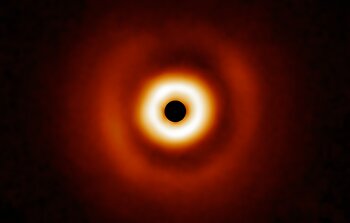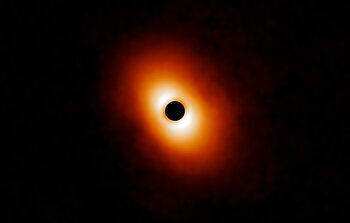Dusty Disks Imaged from NSF NOIRLab
June 15, 2022
Images from the Gemini South telescope in Chile uncover companions to distant stars

This mosaic of dusty, swirling disks shows a sample of images captured from the International Gemini Observatory, a Program of NSF NOIRLab, as part of an unprecedented survey of 44 young massive stars. An international team used Gemini South in Chile to investigate planet formation and uncovered a potential young Jupiter-mass planet, and confirmed the existence of two brown dwarfs. The images will be presented in sessions today at the 240th American Astronomical Society meeting.
This striking image, taken by astronomers using the Gemini South telescope in Chile, is part of a large survey of 44 young, massive stars by the Gemini Planet Imager (GPI) instrument, which imaged their dusty planet-forming disks — likely to become new solar systems — in near-infrared light. The survey found that the disks circling stars up to three times the mass of the Sun tend to have rings, whereas disks around stars that are more massive than three solar masses do not. This suggests that the more massive stars may form planets slightly differently.
Planets form in disks of gas and dust that encircle young stars just a few million years old and GPI is one of a few instruments in the world capable of resolving these disks. Previous observations have indicated that rings, made of large and small dust grains as well as gas, are often seen in these disks. Exactly what creates these rings is uncertain, but they have been attributed to newborn planets interacting with the disk.
Astronomers conducting a survey called Gemini-LIGHTS (Gemini-Large Imaging with GPI Herbig/T-Tauri Survey) have sought to try and answer some of these questions by producing high-resolution images of the disks around a sample of 44 stars.
“We want to answer the fundamental question of how planets form,” said Evan Rich, who is a postdoc at the University of Michigan and the lead author of a new paper describing the results in The Astronomical Journal. In particular, he says the Gemini-LIGHTS survey, “concentrates on stars that are more massive than the Sun to investigate the influence that a parent star's mass might have on the planet-formation process.”
Gemini South captured the images of the disks in near-infrared and polarized light. It found disks around 80% of the 44 targeted stars, and also found one new candidate planet (around V1295 Aquilae) and three brown dwarfs. Two of the brown dwarfs (around the stars (V921 Sco and HD 158643)) had already been identified as candidates by earlier observations and which have now been confirmed through these observations; the third brown dwarf, around the star HD 101412, is a new candidate.
The survey’s key finding, however, is that the disks appear to behave differently depending upon the mass of the star they are circling. “Systems with small dust-grain rings are only found around stars with masses less than three times the mass of the Sun,” said Rich. “This is important because forming planets are thought to create the ringed structure, and our findings suggest that the planet formation process might be different for stars larger than three times the mass of the Sun.”
This information will be presented in a press conference and oral presentation today at the 240th American Astronomical Society Meeting.
More Information
This research was presented in a paper to appear in The Astronomical Journal.
The team is composed of Evan A. Rich (Department of Astronomy, University of Michigan, US), John D. Monnier (Department of Astronomy, University of Michigan, US), Alicia Aarnio (University of North Carolina, US), Anna S. E. Laws (Astrophysics Group, University of Exeter, UK), Benjamin R. Setterholm (Department of Astronomy, University of Michigan, US), David J. Wilner (Center for Astrophysics, Harvard & Smithsonian, US), Nuria Calvet (Department of Astronomy, University of Michigan, US), Tim Harries (Astrophysics Group, University of Exeter, UK), Chris Miller (Department of Astronomy, University of Michigan, US), Claire L. Davies (Astrophysics Group, University of Exeter, UK), Fred C. Adams (Department of Astronomy, University of Michigan & Physics Department, University of Michigan, US), Sean M. Andrews (Center for Astrophysics, Harvard & Smithsonian, US), Jaehan Bae (Department of Astronomy, University of Florida, US), Catherine Espaillant (Department of Astronomy & Institute for Astrophysical Research, Boston University, US), Alexandra Z. Greenbaum (IPAC, Caltech, US), Sasha Hinkley (Astrophysics Group, University of Exeter, UK), Stefan Kraus (Astrophysics Group, University of Exeter, UK), Lee Hartmann (Department of Astronomy, University of Michigan, US), Andrea Isella (Department of Physics & Astronomy, Rice University, US), Melissa McClure (University of Amsterdam, Netherlands), Rebecca Oppenheimer (Astrophysics Department, American Museum of Natural History, US), Laura M. Pérez (Departamento de Astronomía, Universidad de Chile, US), Zhaohuan Zhu (Department of Physics & Astronomy, University of Nevada, US)
NSF NOIRLab(National Optical-Infrared Astronomy Research Laboratory), the US center for ground-based optical-infrared astronomy, operates the International Gemini Observatory(a facility of NSF, NRC–Canada, ANID–Chile, MCTIC–Brazil, MINCyT–Argentina, and KASI–Republic of Korea), Kitt Peak National Observatory (KPNO), Cerro Tololo Inter-American Observatory (CTIO), the Community Science and Data Center (CSDC), and Vera C. Rubin Observatory(operated in cooperation with the Department of Energy’s SLACNational Accelerator Laboratory). It is managed by the Association of Universities for Research in Astronomy (AURA) under a cooperative agreement with NSF and is headquartered in Tucson, Arizona. The astronomical community is honored to have the opportunity to conduct astronomical research on Iolkam Du’ag (Kitt Peak) in Arizona, on Maunakea in Hawai‘i, and on Cerro Tololo and Cerro Pachón in Chile. We recognize and acknowledge the very significant cultural role and reverence that these sites have to the Tohono O'odham Nation, to the Native Hawaiian community, and to the local communities in Chile, respectively.
Links
Contacts
Evan Rich
earich@umich.edu
University of Michigan
Amanda Kocz
amanda.kocz@noirlab.edu
+1 520 318 8591
Communications Manager
NSF NOIRLab







